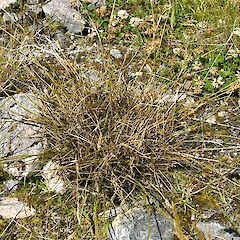Carex edgariae
Common name
Edgar’s sedge
Synonyms
None
Family
Cyperaceae
Flora category
Vascular – Native
Endemic taxon
Yes
Endemic genus
No
Endemic family
No
Structural class
Sedges
NVS code
The National Vegetation Survey (NVS) Databank is a physical archive and electronic databank containing records of over 94,000 vegetation survey plots - including data from over 19,000 permanent plots. NVS maintains a standard set of species code abbreviations that correspond to standard scientific plant names from the Ngä Tipu o Aotearoa - New Zealand Plants database.
CAREDG
Chromosome number
2n = c.60
Current conservation status
The conservation status of all known New Zealand vascular plant taxa at the rank of species and below were reassessed in 2017 using the New Zealand Threat Classification System (NZTCS) – more information about this can be found on the NZTCS website. This report includes a statistical summary and brief notes on changes since 2012 and replaces all previous NZTCS lists for vascular plants.
Please note, threat classifications are often suggested by authors when publications fall between NZTCS assessment periods – an interim threat classification status has not been assessed by the NZTCS panel.
- Conservation status of New Zealand indigenous vascular plants, 2017 . 2018. Peter J. de Lange, Jeremy R. Rolfe, John W. Barkla, Shannel P. Courtney, Paul D. Champion, Leon R. Perrie, Sarah M. Beadel, Kerry A. Ford, Ilse Breitwieser, Ines Schönberger, Rowan Hindmarsh-Walls, Peter B. Heenan and Kate Ladley. Department of Conservation. Source: NZTCS and licensed by DOC for reuse under the Creative Commons Attribution 4.0 International licence.
2017 | At Risk – Naturally Uncommon | Qualifiers: DP, Sp
Previous conservation statuses
2012 | At Risk – Naturally Uncommon | Qualifiers: Sp
2009 | At Risk – Naturally Uncommon | Qualifiers: DP
2004 | Sparse
Distribution
Endemic. South Island where confined to western Central Otago especially between Lakes Wanaka and Wakatipu.
Habitat
A species of montane to subalpine tussock grassland where it growsin wet flushes, seepages and in damp sites near rock overhangs.
Detailed description
Reddish-green to wine-red, shortly rhizomatous, tufted sedge. Rhizome 1–1.5 mm diameter. Culms 20–150 × 1 mm, cylindrical, glabrous; shorter culms almost hidden with grey-brown to light yellow-brown leaf sheaths. Leaves > or occasional < culms, 1–2 mm wide, concavo-convex, margins and rarely the keel scabrid toward leaf apex. Inflorescence of 3–6 approximate, sessile spikes; lowermost spike in well grown plants often distant; terminal spike male, glumes ovate, usually entire, creamy brown; remaining spikes female, clustered round base of male spike, 5–10 × 3–4 mm. Glumes for about ½ length of the utricles ovate, almost hyaline with light red-brown striations, midrib cream, scabrid at the apex, apex occasionally extended as a minute awn. Utricles 1.5–2.5 × 1 mm, ovoid-ellipsoid, cream at the base with red-brown to black markings on the upper half, nerves distinct in lower half, margins glabrous; beak minute up to 0.3 mm long, crura entire or minutely bidentate, finely scabrid; stipe usually minute or up to 0.5 mm long. Stigmas 3. Nut 1 x 1 mm, dark grey-brown, obovoid, trigonous with rounded angles.
Similar taxa
Perhaps closest to C. libera (Kük.) Hamlin which is endemic to North West Nelson and differs most notably by the red-tipped rather than black-tipped utricles, and by the glumes of female spikelets being about the same length, rather than half the length of the utricles. The glumes of male spikelets are creamy brown and usually entire in C. edgariae, while those of C. libera are usually reddish-brown and distinctly awned.
Flowering
September–December
Fruiting
October–April
Life cycle
Nuts surrounded by inflated utricles are dispersed by granivory and wind (Thorsen et al., 2009).
Propagation technique
Easily grown in a pot or sunny damp site in a garden. Tolerant of a wide range of soil types and conditions. The reddish green foliage and dark red-brown to black utricles make this a particularly attractive sedge.
Threats
A biologically sparse, naturally uncommon species that appears to be more under collected than it is actually threatened.
Etymology
carex: Latin name for a species of sedge, now applied to the whole group.
Attribution
Description adapted from Moore and Edgar (1970)
References and further reading
Moore LB, Edgar E. 1970. Flora of New Zealand, Volume II. Indigenous Tracheophyta: Monocotyledones except Gramineae. Government Printer, Wellington, NZ. 354 p.
Thorsen MJ, Dickinson KJM, Seddon PJ. 2009. Seed dispersal systems in the New Zealand flora. Perspectives in Plant Ecology, Evolution and Systematics 11: 285–309.





